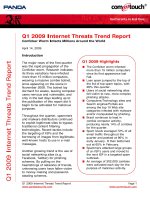Causes of Unemployment around the World
Bạn đang xem bản rút gọn của tài liệu. Xem và tải ngay bản đầy đủ của tài liệu tại đây (83.14 KB, 4 trang )
Causes of Unemployment around the World
Causes of Unemployment
around the World
By:
OpenStaxCollege
The causes of unemployment in high-income countries of the world can be categorized
in two ways: either cyclical unemployment caused by the economy being in a recession,
or the natural rate of unemployment caused by factors in labor markets, such as
government regulations regarding hiring and starting businesses.
Unemployment from a Recession
For unemployment caused by a recession, the Keynesian economic model points out that
both monetary and fiscal policy tools are available. The monetary policy prescription
for dealing with recession is straightforward: run an expansionary monetary policy
to increase the quantity of money and loans, drive down interest rates, and increase
aggregate demand. In a recession, there is usually relatively little danger of inflation
taking off, and so even a central bank, with fighting inflation as its top priority, can
usually justify some reduction in interest rates.
With regard to fiscal policy, the automatic stabilizers discussed in Government Budgets
and Fiscal Policy should be allowed to work, even if this means larger budget deficits
in times of recession. There is less agreement over whether, in addition to automatic
stabilizers, governments in a recession should try to adopt discretionary fiscal policy of
additional tax cuts or spending increases. In the case of the Great Recession, the case
for this kind of extra-aggressive expansionary fiscal policy is stronger, but for a smaller
recession, given the time lags of implementing fiscal policy, discretionary fiscal policy
should be used with caution.
However, the aftermath of the Recession emphasizes that expansionary fiscal and
monetary policies do not turn off a recession like flipping a switch turns off a lamp. Even
after a recession is officially over, and positive growth has returned, it can take some
months—or even a couple of years—before private-sector firms believe the economic
climate is healthy enough that they can expand their workforce.
1/4
Causes of Unemployment around the World
The Natural Rate of Unemployment
Unemployment rates in the nations of Europe have typically been higher than in the
United States. In 2006, before the start of the Great Recession, the U.S. unemployment
rate was 4.6%, compared with 9% in France, 10.4% in Germany, and 7.1% in Sweden.
The pattern of generally higher unemployment rates in Europe, which dates back to the
1970s, is typically attributed to the fact that European economies have a higher natural
rate of unemployment because they have a greater number of rules and restrictions that
discourage firms from hiring and unemployed workers from taking jobs.
Addressing the natural rate of unemployment is straightforward in theory but difficult
in practice. Government can play a useful role in providing unemployment and welfare
payments, passing rules about where and when businesses can operate, assuring that the
workplace is safe, and so on. But these well-intentioned laws can, in some cases, become
so intrusive that businesses decide to place limits on their hiring.
For example, a law that imposes large costs on a business that tries to fire or lay off
workers will mean that businesses try to avoid hiring in the first place, as is the case in
France. According to Business Week, “France has 2.4 times as many companies with 49
employees as with 50 ... according to the French labor code, once a company has at least
50 employees inside France, management must create three worker councils, introduce
profit sharing, and submit restructuring plans to the councils if the company decides to
fire workers for economic reasons.” This labor law essentially limits employment (or
raises the natural rate of unemployment).
Undeveloped Labor Markets
Low-income and middle-income countries face employment issues that go beyond
unemployment as it is understood in the high-income economies. A substantial number
of workers in these economies provide many of their own needs by farming, fishing, or
hunting. They barter and trade with others and may take a succession of short-term or
one-day jobs, sometimes being paid with food or shelter, sometimes with money. They
are not “unemployed” in the sense that the term is used in the United States and Europe,
but neither are they employed in a regular wage-paying job.
The starting point of economic activity, as discussed in Welcome to Economics!, is
the division of labor, in which workers specialize in certain tasks and trade the fruits
of their labor with others. Workers who are not connected to a labor market are often
unable to specialize very much. Because these workers are not “officially” employed,
they are often not eligible for social benefits like unemployment insurance or old-age
payments—if such payments are even available in their country. Helping these workers
to become more connected to the labor market and the economy is an important policy
goal. Indeed, recent research by development economists suggests that one of the key
2/4
Causes of Unemployment around the World
factors in raising people in low-income countries out of the worst kind of poverty is
whether they can make a connection to a somewhat regular wage-paying job.
Key Concepts and Summary
Cyclical unemployment can be addressed by expansionary fiscal and monetary policy.
The natural rate of unemployment can be harder to deal with, because it involves
thinking carefully about the tradeoffs involved in laws that affect employment and
hiring. Unemployment is understood differently in high-income countries compared to
low- and middle-income countries. People in these countries are not “unemployed”
in the sense that term is used in the United States and Europe, but neither are they
employed in a regular wage-paying job. While some may have regular wage-paying
jobs, others are part of a barter economy.
Self-Check Questions
What are the different policy tools for dealing with cyclical unemployment?
If there is a recession and unemployment increases, we can call on an expansionary
fiscal policy (lower taxes or increased government spending) or an expansionary
monetary policy (increase the money supply and lower interest rates). Both policies
stimulate output and decrease unemployment.
Explain how the natural rate of unemployment may be higher in low-income countries.
Aside from a high natural rate of unemployment due to government regulations,
subsistence households may be counted as not working.
Review Questions
What are the two types of unemployment problems?
In low-income countries, does it make sense to argue that most of the people without
long-term jobs are unemployed?
Critical Thinking Question
Is it possible to protect workers from being fired without distorting the labor market?
Explain what will happen in a nation that tries to solve a structural unemployment
problem using expansionary monetary and fiscal policy. Draw one AD/AS diagram,
based on the Keynesian model, for what the nation hopes will happen. Then draw a
3/4
Causes of Unemployment around the World
second AD/AS diagram, based on the neoclassical model, for what is more likely to
happen.
Problems
Retrieve the unemployment data from The World Bank database
( for India, Spain, and South Africa for
2008–2012. Prepare a chart that compares India, Spain, and South Africa based on the
data. Describe the key differences between the countries. Rank these countries as high-,
medium-, and low-income countries. Explain what is surprising or expected about this
data. How were these countries impacted by the Great Recession?
References
Viscusi, Gregory, and Mark Deen. “Why France Has So Many 49-Employee
Companies.”
Business
Week.
Last
modified
May
3,
2012.
/>
4/4









